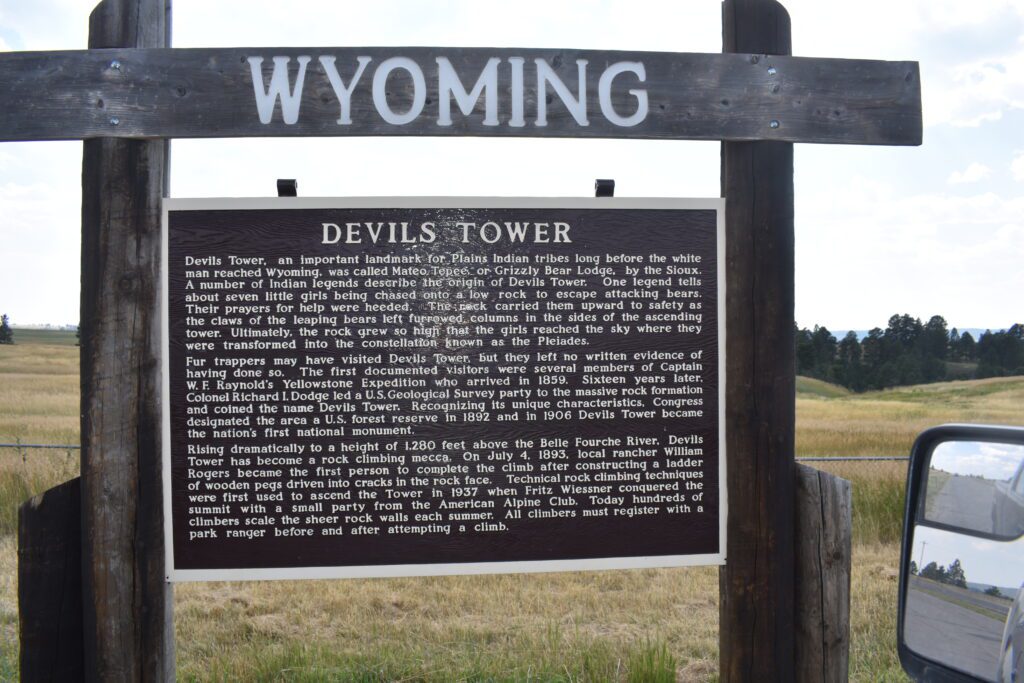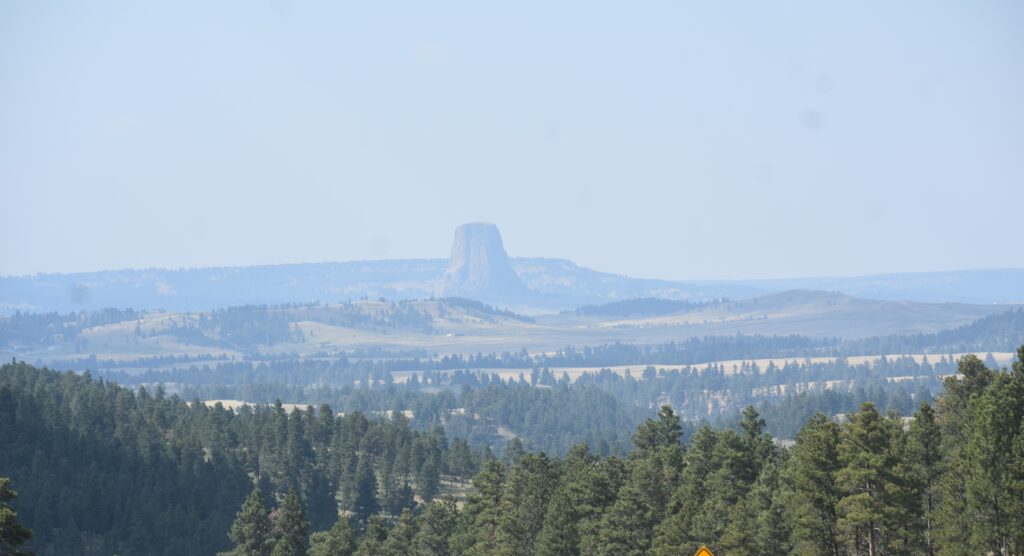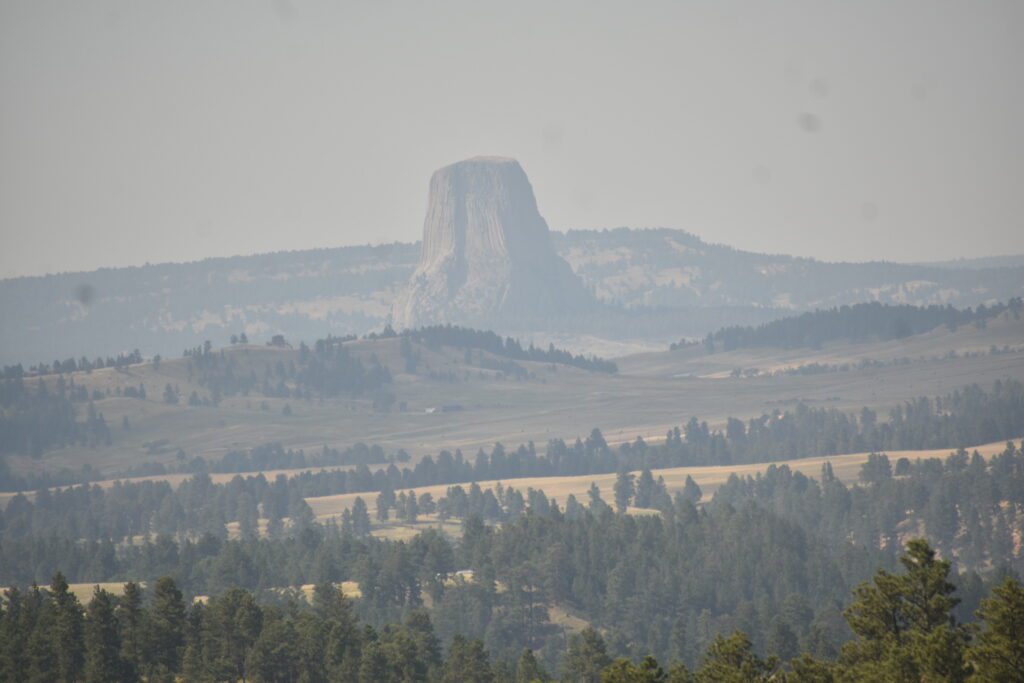News
History: Devil’s Tower Declared National Monument in 1906

Devil’s Tower, near Sundance Wyoming, is well known to most people in Wyoming. In September of 1906, President Theodore Roosevelt declared it the First National Monument in the United States.
It towers over the plains in Crook country and can be seen from Interstate 90 near Moorcroft. It has puzzled humans since they first saw it. One of the earliest references from the old newspapers was this article in The Sundance Gazette, September 19, 1885 – The following lengthy description of the famous Devil’s Tower, of this County, is taken from Newton and Jenney’s report of the geology of the land and resources of the Black Hills. The Bear Lodge— Mato Tepee— this name appears on the earliest map the region, and though more recently it is said to be known among the Indians as “the bad God’s tower, or in better English, “the devil’s tower,” well applied, is still retained.
It stands on the immediate western bank of the Belle Fourche, about four miles southeast of the Little Missouri buttes. It was not reached by the Warren expedition, but while the Raynolds expedition was in the vicinity of the Little Missouri river, two attempts, the last successful, were made by Mr. Hutton to reach it.
The Raynolds Expedition, led by topographical engineer Captain William F. Raynolds, was an army exploring and mapping expedition sent to map the territory between Fort Pierre Dakota Territory, to the headwaters of the Yellowstone River in what is now Yellowstone National Park.
He (Hutton) recorded, however, no particular disruption of it so that when we reached it in 1875 our examination had all the claim of novelty. Its remarkable structures, its symmetry, and its prominence made it an unfairly source of wonder. It is a great rectangular obelisk of trachyte, with a columnar structure, giving it a vertically striated appearance, and it rises 625 feet, almost perpendicular, from its base. Its summit is so entirely inaccessible that the energetic explorer, to whom the ascent of an ordinarily difficult crag is but a pleasant pastime, standing at its base could only look upward in despair of ever planting his foot on top. At a distance it resembles, not a little, the unfinished Washington monument, in Washington City, with the difference, however, that nature has completed her work, (The Washington Monument was completed in 1884)
Within a half mile of the bank of the Belle Fouche, the shaft raises with its broad base of debris from the plateau formed by the lower Jurassic sandstone. Its dimensions were determined by Captain Tuttle, the astronomer of the expedition, who calculated them from measurements with the sextant. The height of the summit above the river was found to be 1,126 feet, while approximately its elevation above the sea is 5,250 feet. Width of the summit from north to south is 376 feet, and the width at base is 796 feet in an east and west direction the diameters are less.
The rock is coarsely porphyritic samdin-trachyte of a greenish color, closely resembling that of Terry Peak. In the muss it has a crystal like structure on a grand scale, which from a short distance gives the column the appearance of a foscicle of gigantic fibers. From the base, which is considerably broader then the body of the peak, each fiber-like crystal or column raises in a bold curve to the bottom of the vertical obelisk, which it then follows to the summit. The columns have generally rectangular or rombic section, but are sometimes triangular or hexagonal. With the exception of an occasional fracture, each column or crystal continues to the very summit. The sides are of various dimensions, but average from two to four feet at the base. They diminish upward with the total columns the same ratio.
Careful examination at the base shows that the columnar structure is not continuous below the portion of the peak exposed to view. The columns differ somewhat in size and position from those characteristic of basalt. The latter are commonly referred to contraction in cooling, occasionally combined perhaps with a concretionary action; and they are always formed perpendicular to a surface of cooling. In a dike they are perpendicular to the walls, and in an overflow to the atmospheric surface. They are rarely of any great length, and frequently they extend but a part of the way through the bed, ending irregularly in a structure less mass. In the Bear Lodge we have columns over six hundred feet in length rising perpendicularly from a seemingly massive base. It is exceedingly difficult to account for this as a result of cooling by comparison with any known basaltic phenomena; and, indeed, Bear Lodge, in its shape and structures appear not to have been repeated elsewhere by nature. but stands alone unique and mysterious.

As early as 1890, there was a move to preserve the tower for all peoples. This from Wyoming Weekly Republican, Sundance, on October 15, 1890 – J. C. Grabill, photographer of Deadwood, was in our city on Monday last. He will take some views of the Devil’s Tower and other noted places in this vicinity. He is also circulating a petition that will be presented to congress to have the Devils Tower and the Missouri Buttes reserved from settlement. It does look as though these noted places should be owned by the government and not by private individuals for speculation.
In the Cheyenne Daily Leader, May 1, 1907, it talks about the president declaring it a national monument. – One of Most Remarkable Formations on the Globe set aside the national reserve. Following the official proclamation of the segregation of the Devil’s Tower national reserve…. in Crook county, Wyoming: ‘ “Whereas it is provided by section two of the act of congress, approved June 8, 1906, entitled, ‘An act for the, preservation of American antiquities, that the president of the United States is hereby authorized, in his discretion, to declare by public proclamation, historic and prehistoric structures, and other objects of historic or scientific interest that are situated upon the lands owned or controlled by the government of the United States to be national monuments, and may reserve as a part thereof parcels of land, the limits of which in all cases shall be confined to the smallest area compatible with the proper care and management of the object to be protected.
“And, whereas, the lofty and isolated rock in the state of Wyoming, known as the ‘Devil’s Tower,” situated upon the public lands owned and controlled by the United States is such an extraordinary example of the effect of erosion in the higher mountains as to be a natural wonder and object of historic and great scientific interest, and it appears that the public good would be promoted by reserving this tower as a national monument with as much land as may be necessary for the proper protection thereof.
“Now, therefore, I, Theodore Roosevelt, president of the United States of America, by virtue of the power vested by section two of the aforesaid act of congress, do hereby set aside as the Devil’s Tower national monument, the lofty and isolated rock situated in Crook County, Wyoming, as shown upon the map here to attached and made a part of this proclamation.
“Warning is hereby expressly given to all unauthorized persons not to appropriate, injure or destroy any feature of the natural tower hereby declared to be a national monument or to locate or settle any of the lands reserved and made a part of said monument by this proclamation.
“In witness whereof, I have hereunto set my hand and caused the seal of the United States to be affixed. Done at the city of Washington this 24th day of September, in the year of our Lord one thousand nine hundred and six, and of the Independence of the United States the one hundred and thirty-first. (Seal) THEODORE ROOSEVELT. “By the President: ALVEY A. ADEE, “Acting Secretary of State.

And this story from the Cheyenne State Leader, July 4, 1920 telling the Sioux Indian legend of how the Tower was formed. – Governor speaks in shadow of Freak of Nature. Moorcroft – Perhaps no Fourth of July celebration will be held in a more ‘interesting’ setting that which today drew to the foot of Devils Tower. The celebration held today because tomorrow, the fourth, is on Sunday, and took place in the shadow of a mighty basalt monolith which rises almost sheer 1300 feet from the top of a hill 22 miles northeast of Sundance, and about 30 mile short of this place, the nearest railroad point.
A feature of the day’s entertainment was a speech by Gov. Robert Carey and a speech by State Commissioner of Immigration Charles S. Hill,
A part of today’s festivities at the Tower, Adjutant General Timothy J. McCoy of Cheyenne has made public a new legend regarding Devil’s Tower. This story recently was obtained by General Hugh L. Scott, U.S. Army retired, from an aged Sioux warrior, and by the general was transmitted to Major McCoy, an authority on Indian history in Wyoming.
Ages and ages ago, according to the story told General Scott by the old Indian, seven Indian maidens were disporting themselves on the hill where Devils Tower how stands when they were attacked by bears. They took refuge on a rock and beseeched Manitou to preserve them. The ravenous bears rushed at the rock and began climbing up its sides, but miraculously the rock began to grow higher. The higher the bears climbed, the taller the rock became until finally it was the mighty eminence now called by the white men, Devil’s Tower, but which, said the old Indian, the Sioux always identified as Bear Lodge because of its origin and its resemblance in form to a gigantic Indian tepee.
The bears, the old warrior continued, finally desisted in their efforts to reach the maidens but not before their claws had scratched tremendous furrows in the sides of the growing rock and the rock had become so tall that while safe from the bears, the maidens were unable to descend and perished miserably from thirst and starvation.

Their spirits, the old Sioux related, ascended into the sky and became seven stars in a constellation which appears directly above Bear Lodge on the anniversary of the miracle of the growing rock.
In substantiation of his story the Indian pointed out the fact that the bones of many bears have been found at the base of the rock, early white explorers record that they found numbers of bear skulls there. These, he stated, being the bears that were shaken from the rock by its rapid uprising, and which perished from the fall. And he called attention to the perpendicular serrations, hundreds of feet in length, on the sides of the rock, which, he asserted, were caused by the sharp claws of the climbing bears.
Later, according to the Wyoming Stockman-Farmer, November 1, 1920 – Congressman F. W. Mondell may introduce in the lower house of congress a bill to change the name of Devil’s tower, a natural freak in Crook county, north of Newcastle, to ‘”Matoe Tepee,” a Sioux name, meaning “Lodge of the Great Bear,” Devil’s tower, several years ago, was made a national monument, the land on which it is standing being segregated for park purposes, and it is within the province of congress to change the name. Indian legend makes “Matoe Tepee” an appropriate name, the Sioux believing that the tower-like rock was reared by Manitou to preserve several Indian maidens from a horde of giant bears.

There was even talk of building a staircase to the top of the tower. This from the Inter Mountain Globe, Hulett, March 10, 1910 –Devil’s Tower, Hon. W.P. Smith has written to Hon. Frank Mondell in reference to the Devil’s Tower Monument. He suggested an iron stairway to the top of the monument. Mr. Mondell has incorporated the idea into a bill and introduced it. The bill reads as follows: Be it Enacted, By the Senate and House of Representatives of the United States of America in Congress assembled; That there is hereby appropriated out of any moneys in the Treasury not otherwise appropriated, the sum of $10,000, for the purpose of building an iron stairway from the foot to the summit of the “Devil’s Tower, situated in the Devil’s Tower National Monument, in Crook County, Wyoming.
Wyoming has many wonders, and has several ‘firsts’, including Yellowstone National Park in 1872; and the first national forest – Shoshone National Forest in 1891, but Devil’s Tower is one of the most unique natural wonders in the state, and became a national monument 117 years ago this month.

